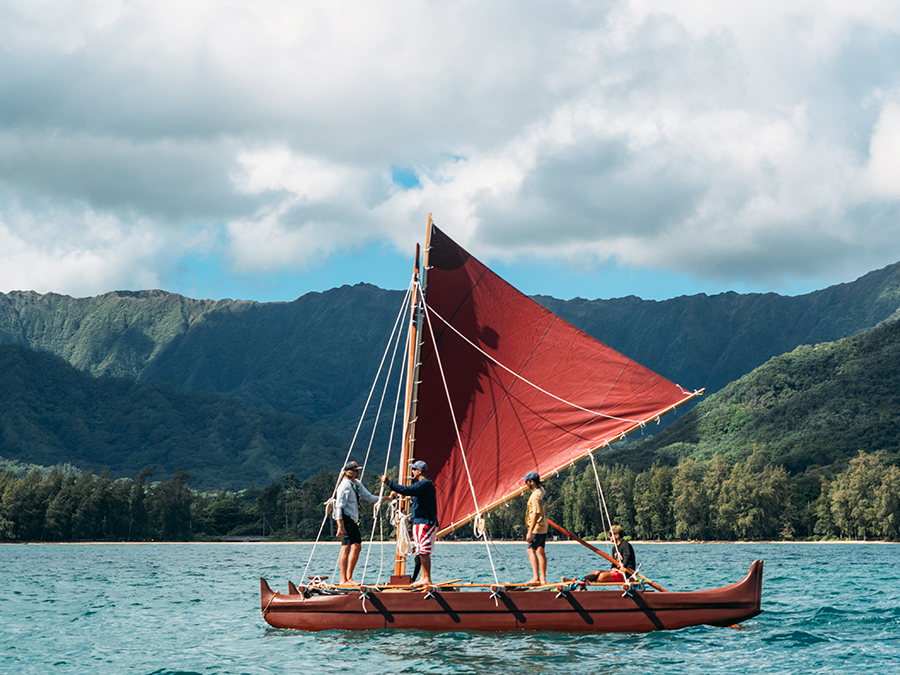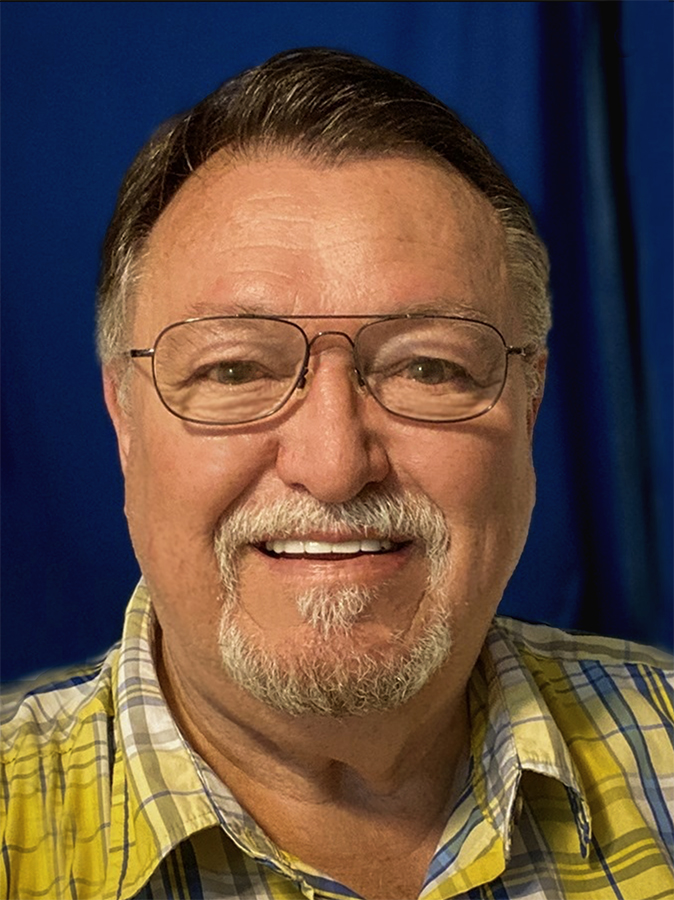
Unless you’ve been closely following Brigham Young University–Hawaii’s 57-foot traditional wa’a kaulua (twin-hulled) traditional sailing canoe, Iosepa, that can usually be seen in the Polynesian Cultural Center’s Hawaiian Village, you might not be aware the two institutions entered into closer agreement in April 2023 to get the wa’a ready to sail again by summer 2024.
Keali’i Haverly, Center Vice President of Sustainability, Cultural Theming, Projects and Maintenance, recently shared details of the new agreement [ LINK to that article ] and putting the Iosepa into drydock mode to completely overhaul it.
BUT even those familiar with the Iosepa may not have heard anything yet about ANOTHER Cultural Center canoe — Ka ‘Uhane Holokai, the “Soul of the Seafarer.”
The Center commissioned Hauula resident Mark Holladay Lee — who some people know as a professional photographer but may not realize he’s also a highly qualified waterman — to build the 24-foot Ka ‘Uhane Holokai as a training canoe for a future Iosepa crew. Indeed, Ka ‘Uhane has already been sailing around Kahana and Kaneohe Bay.
But first, Mark Lee the canoe maker: Mark said he was conceived in Hawaii when his dad was in the military, and thereafter moved to other places about every two years. For instance, he graduated from high school in Delaware, but came to Laie in 1996 to attend BYU–Hawaii. While here, he learned to shape surfboards and work on boats from the lawai’a (fishermen) of Kahana.
Taking a hiatus from school, Mark went to the U.S. mainland where he became a commercial diver, did underwater construction, and worked in the marine industry. Then he went to New York City where he became a professional photographer. Coming back to Hawaii in 1998, he enrolled his kids in the Hawaiian immersion program and continued working in photography, video, and as a documentary maker for various Hawaii nonprofits.
In May 2022, Haverly asked him if he knew anyone who did fiberglass work and might be interested in working on the Center’s pageant canoes that nobody had touched since the COVID pandemic.
Haverly ended up hiring Mark and soon asked him if he could put “rigging” — i.e., a traditional canoe mast, spar, and boom — on one of the existing pageant canoes. He added such a repurposed canoe could be floated on the lagoon by the Hawaiian Village, as sort of a “mini-Iosepa,” to test the concept of further showcasing traditional voyaging.
“I don’t know,” Mark replied, but he later changed his answer to, “I will need to cut one in half to turn it into a double-hulled canoe.”
“What? Wait, no!” Keali’i initially responded, but he also eventually changed that to, “Do it,” after Mark offered additional convincing explanations.
Four-to-five months later, Mark had closed up the twin fiberglass hulls with higher gunnels, added compartments in the hulls with little bulkheads [as a safety measure; on larger canoes, the inner hulls act as a “hold” and also limited sleeping space for crewmembers], shaped and attached new ‘iako — the beams stretching across the hulls to hold them together, and created new bows and prows on the ends.
He also added a heiau — what Hawaiians call the piece where the mast attaches to the deck, plus a koa-wood hoeuli or rear sweep to steer the canoe, which he scavenged, and he ordered properly-sized main and genoa sails. [The latter is larger than a jib sail rigged connecting to the bow that extends past the mast and overlaps the main sail.]
About this time Kahia Walker, who had been sailing the recent Alaska leg on the well-known Hōkūle’a canoe, returned to Laie in time to do all the new canoe lashings.
Keali’i said Ka ‘Uhane ultimately came together with hundreds of hours of efforts at what are now called “canoe workdays” — drydock and training sessions started several months earlier and still continuing today, every Wednesday afternoon at the Iosepa canoe gate.

Ka ‘Uhane’s symbolism: Mark noted he also created a total of six pointed designs on the canoe’s deck. “The [designs on the] first two represent moving forward. The next two, in negative space, have backward pointing triangles, representing our history and the knowledge of our kūpuna that brought us here; and on the far outside we have tiny triangles representing our keiki bringing us all together.”
“It’s a very powerful design. For example, I built all of them as the ‘grip’ on the deck so we wouldn’t slide when it got wet. I’ve built many surfboards, with all different kinds of ‘flows,’ but this was one of the most emotional ones for me. As soon as we towed it out at Kahana, even though there were only pretty light winds, we could just feel it wanting to go upwind. Then, as soon as the sails caught wind, we were sailing. It was out there.”
“We all shared a huge learning process,” Mark continued. “It took about seven months from starting with the dance canoe to get it into the water for the first time” as a sailing canoe less than half the size of the Iosepa. Of course, being mostly made out of fiberglass, Ka ‘Uhane is much lighter than the Iosepa.
Sailing Ka ‘Uhane Holokai: “We’ve sailed it twice so far,” Mark continued. “The first time was amazing. The first time I felt the wind in the sail, it was powerful.”; and on its second voyage, he said they took Ka ‘Uhane out past the sandbar to the last channel marker in Kaneohe Bay.
“I think the most important thing I learned that day was communication. When the captain gives an order or command, the crew clarifies they heard that command and understand. That’s very much like in life.”
Mark estimates Ka ‘Uhane “can comfortably sail with eight-to-ten people, space-wise. Weight-wise, it could probably handle 15, but I wouldn’t take anybody out who didn’t know what they were doing.”
He added with the tandem-axle marine trailer they use and a heavy-duty pickup truck, they can transport Ka ‘Uhane Holokai anywhere on the island. “The canoe and the trailer are also completely registered with the State, and have HJ and VIN numbers. It’s 100% legal.”
What’s the future for Ka ‘Uhane Holokai? “As with all things, there are many more opportunities of use than the originally intended purpose,” Keali’i shares. “Ka ‘Uhane’s time will typically be spent in PCC’s lagoon, educating staff and Center visitors on the mechanics and purposes of Polynesian voyaging.”
“Guests can interact with Ka ‘Uhane when the Center is open in the near future, whether on deck themselves, or by watching trained PCC staff on deck while they are safely pier-side.”
“But when the Center’s villages are closed in the early morning, late evening, or on Wednesdays [when the Center is usually closed under the new post-COVID schedule],” Keali’i continued, “don’t be surprised to see Ka ‘Uhane being trailered to a nearby boat ramp or community event.”
Mark also commented, “With Iosepa, its time on the water is relatively limited, but with a small training canoe like Ka ‘Uhane, I would love to also use it to train young people, if the Center would allow it.”
“It could be put on a trailer and driven to schools, where kids can come aboard, learn the names of all the parts, and how to open and close the sails together, all while learning how to work as a team.”
“It can be used as a training vessel for many years to come. It can be put on the water and be sailing within an hour,” Mark continued. “It’s also a connector for our community. This could be a way to bring together all the people of Hawaii. Our people should be water people. We live by the most beautiful oceans in the world, and I’m excited to start teaching our children to get in the water.”“I’ve heard that [the late] Papa Mau [the Satawal navigator who originally taught Hawaiians traditional wayfinding before they finished building the Hōkūle’a in 1975] said (roughly paraphrasing), ‘Bring me young people, who start at an age to learn the principles of even how to behave on a wa’a. It’s not something you learn in one class, over a semester or two semesters, or two years. It takes a lifetime of learning.”


Mike Foley, who also goes by his Sāmoan and Hawaiian name Mikaele, first visited the Polynesian Cultural Center on his way home from serving for 2.5 years in the Samoa Mission. A few months later, he returned to Laie to enroll at the Church College of Hawaii, and also got a student-job at the Center. He has worked intermittently at the Center ever since, 60-ish years, including about 25 years full-time in marketing communications, PR and advertising. During the earliest of those years, he met and married Sally Ann McShane, a beautiful young Hawaiian dancer (who came to Laie in 1963). They raised their family in Laie and still live there.
View all posts